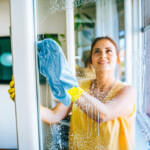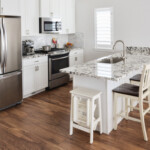When you’re a parent, a big part of your job is controlling the controllable. You can’t see or affect your children’s behavior every moment of every day, but you can eliminate opportunity for them to get injured or into trouble. And while it might seem like the older they get the less you have to worry about hazards in your own home, the trick is to consider worst case scenarios — then find ways to prevent them.
This guide will cover all the items you should keep secured safely away from your children. (Even if you aren’t a parent, many of these steps are helpful if you have friends or family with children who often stop by.) Always keep in mind the curious nature of children and their occasional tendency to disobey warnings; even if your kids are relatively well-behaved, never assume there’s no chance they could slip up, and instead prepare for the possibility that they might. We all make mistakes, children included, but as parents, there are many opportunities to help ensure they stay on the best path possible.
Items to secure
1. Alcohol

In addition to regular conversations with your child about the dangers of alcohol, make sure all of yours — wine, beer, and liquor — is securely locked away. Make it a cabinet that’s somewhat hard to reach and wouldn’t be easily accessed in a rush, even if unlocked. Keep it as out of sight as much as possible so your child or any friends he or she has over won’t often encounter it — and all the better if your child genuinely isn’t sure where you store it. Many people prefer to keep their beer or wine chilled, but only do so if you are able to have a designated “adults-only” refrigerator with a lock.
Keep track of the levels of the alcohol in your home: would you notice if a beer went missing? Would you be able to tell if the bottle of wine you opened two nights ago is still at the same level as you left it? Some parents find it helpful to mark their bottles with pencil marks (keep in mind that requires vigilance to avoid confusion) but for others, taking a mental picture after each use is enough.
Be especially mindful anytime you have parties where alcohol is served, especially if there are multiple kids around. Keep the liquor in an adults-only area and make note of how quickly the alcohol is depleting and whether there seems to be some unaccounted for. Clean up right after the party to eliminate any late-night debauchery and to avoid your child waking up to a mess of bottles and cans.
Ensure that your liquor is all labeled appropriately. Not only will it prevent accidental ingestion, it prevents any claims of ignorance: a teen caught red-handed can’t say he or she didn’t know it was alcohol if the bottle is clearly marked.
One of the major benefits of locking up your personal alcohol is because it also gives your child a genuine out when it comes to peer pressure. If he or she had a friend over who was talking about sneaking some liquor, your child can’t give in because everything is locked away. Be sure you keep the key on you or secured and out of reach at all times — the family safe is a perfect spot.
2. Medications

It’s best that all of your medication is secured, because even over-the-counter (OTC) drugs can be dangerous if taken under the wrong circumstances. Further, while many medications are in “child-resistant” packaging, that isn’t necessarily a substantial safeguard. Older kids eventually learn the tricks, and even younger kids can discover ways to open them without even trying.
Start by throwing out any expired medication, checking the label for proper disposal methods. You should also get rid of any leftover prescription medications, especially opioid painkillers, which must be discarded carefully. Do not flush them down the drain or toilet, as this can actually pollute the water supply. Instead, take advantage of drug take-back programs: the Drug Enforcement Administration (DEA) sponsors a day each year to accepting people’s leftover and expired prescription medications for safe disposal, and communities might have local programs that collect year-round. There are even bags you can buy that allow you to “deactivate” pills, rendering them harmless and easily thrown out.
Put all remaining medications and supplements, from OTC cough syrup to prescription anxiety pills, in a locked cabinet. Keep them all in their original bottles so that they are easily identified and have their safety information readily available. Organize them in a way that makes sense to you, taking special care to keep the children’s medications completely separate from your own, and prescription separate from OTC. Your child should know that he or she must always go to you if they need any medicine, and you should specify with them which other adults have both permission and access to the locked cabinet.
Just as you monitor your personal alcohol levels, you should also keep track of how much medication you have on-hand. You should have a general sense of the amount of cold medicine, pain relievers, and other non-prescription medicines in your cabinet, but the real task is tracking your prescription opioids. Count them regularly and immediately address any discrepancies. It may help for you to note in your calendar or personal planner which days you take them (if dosage is “as needed”) or if you’ve taken your dose for the day (if prescribed a daily dosage). Pay attention to how often you seek refills and how many you are given in a fresh bottle or pack.
If you have any medication that comes in a food-like form (such as gummies), keep those securely stored with your other medications, as well. Make sure you talk to your child about how they may look like a treat, but in fact are a medicine just for you. If it’s a prescription, point out to your child that even you weren’t allowed to take it without a doctor’s permission.
3. Firearms and blades

Children are crafty when they’re curious, and this is never more dangerous than when it comes to a gun. Studies have indicated that boys especially seem to have such an intense fascination with firearms that they often disobey their parents’ warnings and even their own consciences in their pursuit to experiment. Parents, then, must take steps to prevent both access and opportunity to their firearms.
To start, remove any firearms from your home that aren’t used for self-protection — rifles only used on hunting trips, for example — and store them in a gun range locker, a family safe, or another secure location. For guns that remain in the home, they should be locked, and secured with a safety device like a trigger or cable lock. Firearms should always be stored unloaded and ammo locked away somewhere separate. If you use a keyed lock, always keep the key on you or locked in the family safe. If you opt for a combination or keypad lock, be strategic with the code: avoid birthdays, addresses, or any other personal number that could be easily guessed.
The type of storage space you use for your firearm depends largely on available space. Small lock boxes are easily hidden around bedrooms for quick, easy access, but do pose a risk of being stolen by intruders. Gun safes are a larger, more expensive option, but they are often more secure and you can even add a monitoring device that will alert you to any disturbances like an open door or climate change.
If you own any non-culinary knives —box cutters, hunting knives, or pocket knives, for instance — store them in a locked space, as well. Don’t keep them anywhere loose and never in a commonly-accessed location like a kitchen drawer. It’s important for kids to recognize that they are not for casual or unsupervised use under any circumstances, so lock them up and take them out only when necessary.
If you or your partner uses a straight razor to shave or has spare blades around, be sure to lock those up, as well. Young children sometimes pick up and examine shiny objects without evaluating their danger first, and teens may want to emulate your behavior and get a little too ambitious in your absence. A small lockbox by your sink is usually sufficient for these items, but don’t keep the key in an obvious spot like your drawer or in the medicine cabinet.
Additional considerations
Don’t forget to take your security measures outside the house, as well. Lock up the following items in a secure garage cabinet, shed, or other storage space:
- Sharp or dangerous gardening tools
- Fertilizer
- Powered tools and vehicles (like lawn mowers)
- Gas cans
- Old paint (or safely dispose it)
- Fluids or chemicals used for intense cleaning, car maintenance, or home repairs
Keeping these items secure is especially important because they aren’t used daily and thus can be easier to monitor, especially in an outdoor area where your child can generally go without your supervision. If chores require him or her to access the locked space — to mow the lawn, for example — keep a close eye to ensure everything is taken out and put back properly. Supervise the first few ventures into the normally adults-only space, but eventually settle for watching from a distance. It’s important not to constantly hover, but your child still needs to accept that certain tasks require your guidance for everyone’s own safety.
Make sure that after you use any of the items discussed, you immediately put them back into their designated safe spot. Ensure guests in your home understand these rules and do what they can to follow them. Keep in mind you should be especially vigilant if any of your children have been diagnosed with or are exhibiting symptoms of depression. Someone in serious emotional distress can make dangerous, even life-threatening cries for help, so don’t provide any opportunity for your child to harm him- or herself in the heat of anguish.
As your child gets older, he or she may grow frustrated that you “don’t trust them” enough to leave certain things unsecured. Let them know that the locks don’t just keep the entire family safe, they are also a reminder to all that these items are potentially dangerous and should be used with caution and care. Point out that everyone makes mistakes; being imperfect makes us human. And because you accept your child as an imperfect person who will make mistakes, you simply want to protect them the best way you can. Discuss the influence of peer pressure and how it’s led you to make your own share of errors. Emphasize that it is a matter of protection, not trust, and your duty as their parent.
Other popular posts:
DIY Projects for Creating a Dream Backyard for Your Kids



























 United States
United States Canada
Canada